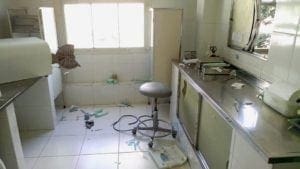Research Lab Autoclave Safety: Bad Doors and Autoclave Explosions
By: Priorclave North America
Category: Lab Autoclaves

WARNING: These are disturbing pictures of research lab autoclave accidents. There is blood.
What happened? A lab tech loaded an older-style autoclave, began the cycle, and walked away to attend to other tasks. Either due to user error or wear-and-tear over time, the door locking mechanism was not fully engaged. As the cycle progressed, the chamber pressure climbed. Mid-cycle the pressure peaked, blowing the door off the autoclave. It struck the worker, who was 50 feet away at the time, resulting in serious injuries.
Note that while the person involved in this incident was only injured, autoclave doors have been responsible for several fatalities. Even when everything operates normally and the autoclave is in good repair, older models can be opened prematurely. The force of the door flying open–even if the hinges hold–can strike a worker with tremendous force.

(source: Colorado State University Biosafety Office)
(Incidentally, this sort of explosion cannot happen with a modern autoclave equipped with computer-controlled permission-based door release and mechanical thermal/pressure interlocks.)
A Cheap Dental Autoclave is a Ticking Bomb
A similar autoclave explosion in a Brazilian dental clinic (here\’s the article Google Translated from the Portuguese).

interior (source)
This incident resulted in no injuries (the autoclave room was empty at the time), but massive structural damage:

exterior of building (source)
In this case, the failure was attributed to metal fatigue. According to the manufacturer, doors should be replaced every five years(!) as a matter of “routine maintenance”(!!!)

detail of damaged autoclave door (source)
Yet another reason we are highly, highly suspicious of second-hand and dental autoclaves in research settings.
Research Lab Autoclave Safety Best Practices
While dramatic, explosions like these are rare. The real danger when operating the autoclave is also the absolutely most mundane thing about it: The heat. Steam autoclaves are effective because steam transfers heat so well, better than air and most lab surfaces. And that steam does not differentiate between red bags and your arms. Stay safe:
- Always wear appropriate PPE
- Don\\’t open the autoclave door until pressure has dropped to 0 psi
- Wait 10 minutes with the door cracked open before removing any materials from the autoclave
- Step to the side when opening the autoclave; keep your face and body clear of the door and any exiting steam
- Never autoclave a tightly capped bottle
- Always check to make sure the door is firmly closed

